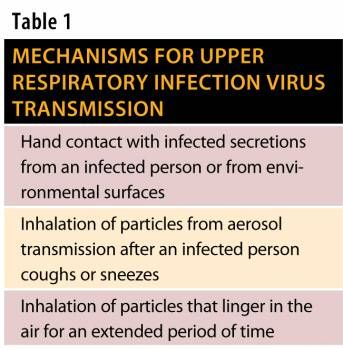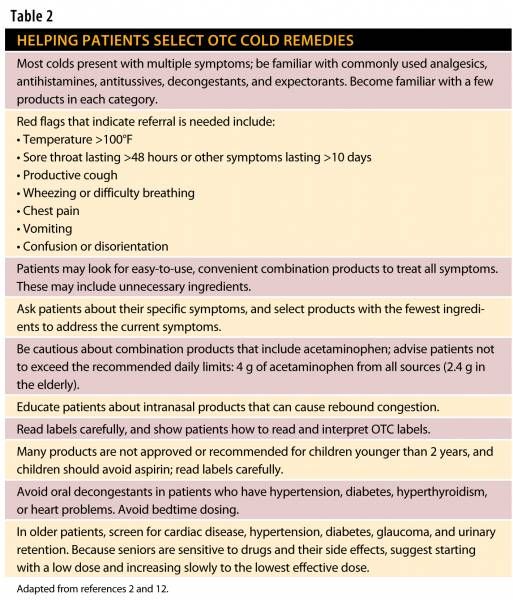Article
What Pharmacists Need to Know for Cold Season
Author(s):
As patients begin presenting to the pharmacy with cold symptoms, here are the top 10 things pharmacists need to know for effective counseling.
As patients begin presenting to the pharmacy with cold symptoms, here are the top 10 things pharmacists need to know for effective counseling.
Ten Top Facts Pharmacists Need to Know
Afflicted patients are easy to spot, but it’s more of an auditory alert than a visual one. As they approach, you hear the labored breathing, sniffles, coughs, and sneezes that warn that another human is inconvenienced, miserable, or starting to develop secondary problems because a virus has docked on the adenoid epithelial cells in the nasopharynx.1,2 Explain it that way, and these red-eyed, panting patients will say, “What do you mean? I just have a cold.”
The common cold is a distinctly human affliction. In the animal kingdom, chimpanzees are the only other animals that develop colds. Colds can strike anytime, but their occurrence begins to climb in the autumn, stays relatively high during the cold winter months, and starts to decline in the spring.2 Children tend to have more colds (an average of 6-8 per year) than adults (2-4 per year), but the signs, symptoms, and duration are about the same.3 Here’s a review of what pharmacists need to know about the common cold as they work to help their patients this cold season.
1. Colds are highly infectious and develop quickly. Caused primarily by human rhinoviruses (HRVs), colds can develop after only a small number of HRVs invade. We know very little about HRVs other than that they are masters of adaptation, and at any given time, more than 100 varieties are circulating. These combined factors make developing immunity almost impossible.3-5 Within 5 to 10 hours of invasion, HRVinfected epithelial cells release soluble inflammatory factors that activate inflammatory cells and coordinate proliferation and chemotaxis.

2. Upper respiratory tract HRV infections are usually relatively harmless.3 Their burden isn’t primarily physiologic—it’s economic. Americans spend more than $60 billion annually trying to alleviate symptoms, and HRV infection seriously reduces productivity at work and at home.6 Risk of contracting a cold increases in environments where people are in close contact (day care, schools, long-term care, hospitals, etc). Evidence indicates that moderate exercise decreases the risk of contracting a cold, but heavy physical exercise actually increases the risk, possibly because of the deep inhalation that accompanies it.2
3. The common cold is highly contagious. Most infection occurs via the mechanisms described in Table 1. Colds occur when a patient touches his or her eyes (and the virus enters the nasopharynx via the lacrimal duct) or nose. The rate of infection is 95% after exposure, and scientists are unsure why the lucky 5% escape misery. About 40% to 75% develop actual symptoms. Viral shedding peaks on day 2 of the cold, but can occur for 3 weeks after infection.2
4. HRV creates cholinergic stimulation. HRV’s hallmark symptoms are sore throat, nasal stuffiness, rhinorrhea, and sneezing. Symptoms tend to peak at day 2 or day 3, and diminish over 7 to 10 days. Over time, the initial watery nasal discharge will thicken and may color, becoming more purulent. Many patients believe this is an indication of a bacterial infection. Pharmacists need to work hard to dispel this myth and decrease the inappropriate use of antibiotics. Additionally, patients may report headache, malaise, and general lethargy. Fever is usually absent, but low grade fever is possible.2
5. The common cold may be beneficial. Some researchers believe that having a cold tunes up the immune system,7 and there is evidence that around 40% of HRV infections are asymptomatic.5
6. The common cold is incurable. Depending on the host’s immune status and typical inflammatory response, the same virus can cause colds that have different presentations in different people. Symptomatic patients will have to let it run its course, usually 7 to 10 days, and most will want medication for symptoms—prescription,

OTC, or complementary. The most common of the complementary treatments are echinacea and zinc. Studies are inconclusive about echinacea’s ability to prevent or reduce symptoms, but at worst, it’s probably harmless.8,9 Zinc seems to shorten the duration of a cold (again, the evidence is not strong), but many people find the strong taste of the lozenges unpalatable.10,11
7. For pharmacists and their patients, symptoms are the main concern. Most patients will not visit a prescriber for a cold. They’ll want an OTC remedy and will often ask their pharmacist for help. Table 2 describes some basics about helping patients with the often overwhelming OTC selection.
8. In a minority of HRV infections, patients may become infected with more dangerous pathogens that lead to sinusitis, otitis media, bronchitis, and pneumonia; experience asthmatic exacerbations; progress to more severe disease in the lower respiratory tract; or develop autoimmunity. Pharmacists should advise parents of young children to monitor for otitis media, because approximately 20% of children who develop a cold will also develop an ear infection. In young children, the frail elderly, and immunocompromised patients, serious bacterial infection may take hold. Individuals with asthma may find their conditions exacerbated and should be forewarned to watch for wheezing or dyspnea and seek help immediately if asthma symptoms are serious.2
9. Researchers know very little about the common cold, but their understanding is growing. HRVs are distantly related to poliovirus, which is vaccine preventable. This suggests that given better understanding of the HRV RNA strand, a vaccine might be possible. In the last few years, researchers have sequenced the entire genome of 99 HRVs, and identified areas of highly conserved motifs (sections of the genome that do not mutate); these areas might be targets for new therapies.13 They have also found areas of the sequence that are pyrimidinerich and probably responsible for the magnitude of specific viruses’ pathogenicity.14 If a vaccine is developed, it will probably resemble the influenza vaccine and be multivalent. That is, it would combine vaccines directed at the HRVs most likely to circulate in the next year. Additionally, some scientists think that HRV could act as a kind of Trojan Horse. They propose tacking a vaccine onto the HRV, which would cause a mild cold, but infecting patients could be a means to introduce vaccines against other diseases.3
10. During a typical 74-year life-span, humans will experience cold symptoms for about 1800 days—that’s 5 years! During about onefifth of those days, the cold will be so severe, bedrest will be necessary.
Ms. Wick is a visiting professor at the University of Connecticut School of Pharmacy and a freelance writer from Virginia.
References
1. Nurani G, Lindqvist B, Casasnovas JM. Receptor priming of major group human rhinoviruses for uncoating and entry at mild low pH environments. J Virol. 2003;77:11985-11991.
2. Heikkinen T, Järvinen A. The common cold. Lancet. 2003;361:51-59.
3. Poland GA, Barry MA. Common cold, uncommon variation. N Engl J Med. 2009;360:2245-2246.
4. Xing L, Casasnovas JM, Cheng RH. Structural analysis of human rhinovirus complexed with ICAM-1 reveals the dynamics of receptor-mediated virus uncoating. J Virol. 2003;77:6101-6107.
5. Kirchberger S, Majdic O, Stockl J. Modulation of the immune system by human rhinoviruses. Int Arch Allergy Immunol. 2007;142:1-10.
6. Mackay IM. Human rhinoviruses: the cold wars resume. J Clin Virol. 2008;42:297-320.
7. Cookson WO, Moffatt MF. Asthma: an epidemic in the absence of infection? Science. 1997;275:41-42.
8. Barrett B, Brown R, Rakel D, et al. Echinacea for treating the common cold: a randomized trial. Ann Intern Med. 2010;153:769-777.
9. Hart A, Dey P. Echinacea for prevention of the common cold: an illustrative overview of how information from different systematic reviews is summarised on the internet. Prev Med. 2009;49:78-82.
10. Das RR, Singh M. Zinc lozenges for the common cold: should we ignore the side-effects? Med Hypotheses. 2011;77:308-309.
11. Singh M, Das RR. Zinc for the common cold. Cochrane Database Syst Rev. 2011;(2):CD001364.
12. Berardi R, Newton G, McDermott JH, et al. Handbook of Nonprescription Drugs. 16th ed. Washington, DC: American Pharmacists Association; 2009.
13. Stone JK, Rijnbrand R, Stein DA, et al. A morpholino oligomer targeting highly conserved internal ribosome entry site sequence is able to inhibit multiple species of picornavirus. Antimicrob Agents Chemother. 2008;52:1970-1981.
14. Palmenberg AC, Rathe JA, Liggett SB. Analysis of the complete genome sequences of human rhinovirus. J Allergy Clin Immunol. 2010;125:1190-1199.





